Originally posted on
dana blogs chess on December 2, 2008.
Richter, Paul - Mackenzie, Dana
Thanksgiving Festival (Milpitas, CA), 11/30/2008
1. e4 e5 2. Nf3 Nc6 3. d4 ed 4. Bc4 Nf6 5. e5 d5 6. Bb5
...
This is a variation of the Two Knights Defense that I lectured about for
ChessLecture last year. Although it's technically known as the Modern Variation,
I suggested that it should be called the Nimzo-Two Knights, because White plans
a blockading strategy that is very much in keeping with Nimzovich's principles.
Ideally, he will cripple Black's queenside pawn structure in such a way that
Black's 4-on-3 majority is neutralized, and then White's 4-on-3 kingside
majority will be decisive.
In the past I have struggled against this variation, but in this game I tried
a new idea that I came up with in a blitz game a few years ago.
6. ... Nd7!? 7. O-O Be7 8. Bxc6 bc 9. Nxd4 Nb8!
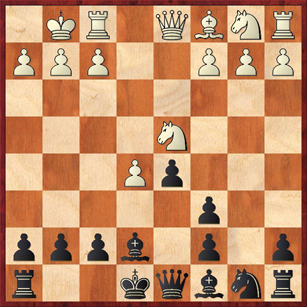
A startling idea. Black has taken two tempi to undevelop his king knight and
put it on the queen knight's original square! What does Black gain as a result?
In a word, flexibility. In the normal lines, his queen bishop goes to
d7 and is hemmed in by the pawns. In this line, Black has kept alive the
possibility for the bishop to develop either on the c8-h3 diagonal or on the
c8-a6 diagonal.
10. f4?! ...
Already a slight error. When I analyzed this variation a few years ago, I
thought that this move was almost automatic. But my master friend, Gjon
Feinstein, called this assumption into question and pointed out that White has
better things that he can do with his tempo, such as 10. c4 or 10. Nc3. The
computer confirms that both of these are better options.
The move 10. f4 here is quite reminiscent of the same move in the Bird
Variation of the Ruy Lopez, which I analyzed in
Bird by Bird, Part 3A. Here, as there, it is very tempting for White to
launch a big kingside pawn storm because of all the empty space that Black has
left on the kingside. But here, as in that variation, the pawn storm is sort of
a red herring. With White's queenside still undeveloped, it's premature, and
it's also out of keeping with the Nimzovichian spirit of this variation for
White. Remember that Nimzovich would first paralyze his opponent with
prophylactic and blockading moves, then launch his attack.
10. ... c5 11. Ne2 f5
I debated long and hard between this move and 11. ... Nc6. I liked 11. ...
Nc6 because it is a developing move, but at this point I still wasn't sure
whether I wanted to put my knight on c6 or a pawn on c6. Also, 11. ... f5 really
stops the whole pawn storm idea in its tracks.
12. ef Bxf6 13. Ng3 O-O 14. Nh5? ...
This definitely looks like a kid's move -- he's wasting so much time with
this knight and neglecting the rest of his pieces. I was sure at this point that
I stood better, but unfortunately I relaxed a little bit and didn't really look
for the most forceful way to take advantage of his mistake.
14. ... Bd4+ 15. Kh1 g6?!
I played this move almost automatically; I was happy to chase his knight away
and simultaneously provide a flight square for my bishop. But the computer says
15. ... Qh4! is much better, threatening 16. ... Bg4 and really putting White in
critical danger already. The first of two big missed opportunities for me.
16. c3 Bh8 17. Ng3 Nc6 18. Na3 Rb8 19. Qc2 Ne7 20. Be3
Qd6 21. Rad1 Qc6 22. Qf2 ...
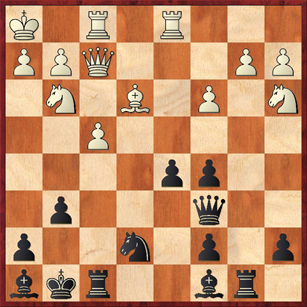
It looks as if White is winning a pawn, because c5 is indefensible and the a7
pawn hangs if Black pushes to c4. But I had great faith in the activity of my
pieces, which are so beautifully posted -- both rooks on open files, the bishops
sitting on 3 (!) important diagonals, and the knight poised to jump to f5 or d5.
I was sure that there must be a way either to get compensation for the lost pawn
or to simply win the pawn back -- it was just a matter of figuring out the right
way.
22. ... d4!
My second-favorite move of this game. It simultaneously bottles up White's
bishop and sets Black's knight free. A pawn is a small price to pay for these
advantages.
23. cd Nd5! 24. dc Nxe3 25. Qxe3 Rxb2 26. Rf2? ...
It turns out that 26. Rd2 would have been better, although Black then easily
wins back the pawn with 26. ... Rxd2 27. Qxd2 Qxc5.
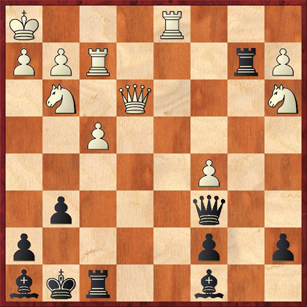
Black to play and win.
The trouble with tournament chess is that you don't have someone tapping you
on the shoulder and saying "Black to play and win." In this position I was
definitely feeling some time pressure. It wasn't bad pressure, but still I had
to make 5 moves in 5 or 6 minutes. And this move looked like one that I could
play automatically, so I played the rook trade after only a few seconds of
thought.
The first moral is, don't get low on time. But the second, and more useful,
moral is to beware of thinking of any move as "obvious." There are no
automatic moves in chess. Even if you have only a few seconds, use those
few seconds to check for the move that comes out of left field, such as
zwischenzugs (in-between moves) or moves played in the opposite order from
what you would expect. I should know this; I've lectured on both of those topics
for ChessLecture. But I failed to apply the principle here.
Have you found the correct move? It's 26. ... Re8!, which basically ends the
game on the spot. Black's pieces control so many squares that the White queen
has only one square to go where it will still protect the f2 rook: 27. Qf3. And
then, rather fortuitously, Black wins the exchange with a nice skewer: 27. ...
Qxf3 28. Rxf3 Bg4!
Well, that would have been a great finish, but the way that the game ended
was pretty good, also.
I played 26. ... Rxf2? 27. Qxf2 Be5! 28. Ne2 and
now I faced another decision, which used up most of my remaining time.
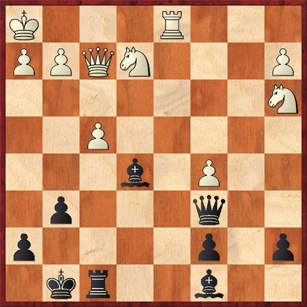
Here I saw 28. ... Qa4, which was my original intention, but I couldn't work
it out to a clear win for Black. Then I remembered another old chess maxim:
The threat is stronger than the execution. In many cases, if you have one
threat, it is best to build up the pressure, and add more threats. Against human
opponents this is especially effective, because you give them more things to
worry about and more things to keep track of, and they are more likely to make a
mistake. Against computers, this psychological aspect disappears, of course.
So I played 28. ... Bb7, a move that ramps up
the pressure against White. Now he has to worry about checkmate on g2, and
therefore ... Bxf4 is now a bona fide threat as well. Meanwhile, the move ...
Qa4 is kept in reserve for future use.
The computer says that 28. ... Qa4 was better, but I refuse to call 28. ...
Bb7 a mistake. The remaining moves of the game show that my decision was fully
justified.
29. Nc4 Bxf4 30. Na5? ...
Better was 30. Nxf4 Rxf4 31. Rd8+ Kg7 32. Qb2+ Qf6 (this is as far as I got
in my time-pressure analysis) 33. Rd7+ Kf8 (or g8) 34. Qxf6+ Rxf6 35. Kg1 Rf7,
with a drawish endgame. But I'm not sure that the endgame is dead drawn -- just
drawish.
30. ... Qa4!
What a great move to have in reserve on the last move of the time control! I
was really glad now that I hadn't played it on move 28.
31. Qe1 ...
This seemingly holds everything together, but ...
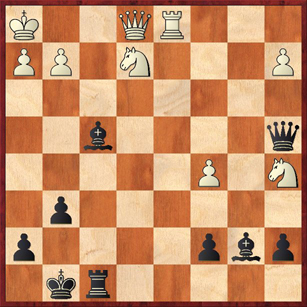
Black to play and win (again!).
Now, of course, I had all the time that I wanted to decide on my next move
(the second time control was game/60). I mentioned earlier that the trouble with
chess is that you don't have someone tapping you on the shoulder and saying,
"Black to play and win." But this position is an exception. It looks exactly
like something that came out of a book: the two Black bishops bearing down on
the kingside, White's pieces clustered in an ineffective lump, all except for
the wandering knight on a5. If ever a position was ripe for a sacrifice, this is
it.
31. ... Bxg2+!
This is my favorite move of the game.
32. Kxg2 Qe4+ 33. Kh3 Re8
The computer likes 33. ... Qf5+ better, but it's just a matter of taste.
34. Nxf4 Qf5+ 35. Kg3 Rxe1 36. Rxe1 ...
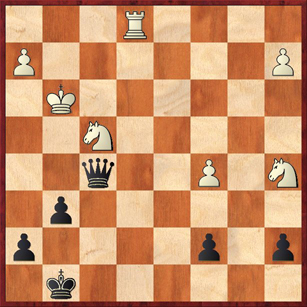
This is as far as I analyzed on move 31. White is still nominally ahead in
material (R+2N versus Q+P) but White's pieces are so scattered and uncoordinated
that I felt certain I would be able to win one of the knights. And, in fact, it
didn't take long to work out a way to do just that.
36. ... Qg5+ 37. Kf3 Qf6!
Threatening both ... Qc3+, which forks everything, and ... g5, which wins the
f4 knight due to the pin on the f-file. There's nothing that White can do. The
rest of the game requires no comment.
38. Kg4 h5+ 39. Kf3 g5 40. Re4 gf 41. Nc4 Qh4 42. Rxf4
Qxh2 43. a3 Qh1+ 44. Kg3 Qg1+ 45. Kh4 Qxc5 46. Kg3 Kg7 47. Kh3 Kg6 48. Rh4 Kg5
49. Re4 Qf5+ 0-1
Aside from the missed win on move 26, a very harmonious game where everything
flowed from the great activity of Black's pieces.
|
